How to bow hunt goats
by Bob Hart
Hunter 5
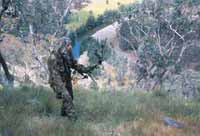
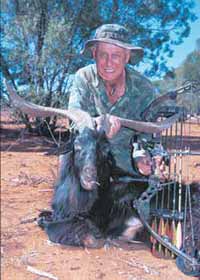
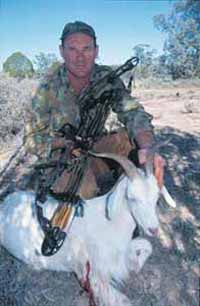
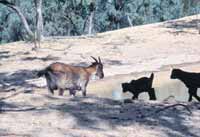
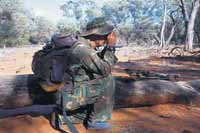 Equipment
Equipment
Bows do not have to have a heavy draw weight for hunting goats. For instance, a bow with a draw weight of about 20kg to 22kg will do just fine and if you shoot a heavier bow, so much the better. The vast majority of hunters today use compound bows, which have cams to reduce the holding weight of the bow. This reduction of holding weight while at full draw means less strain and will aid in making a carefully aimed shot. If you opt for a compound bow, I would strongly recommend a pin sight, which will help make you a more precise shot. A peep sight is added to the bowstring, so that you align the sight through the peep. There is a plethora of types of sights to choose from, but my favourite is the bright, very visible, fibre optic sight. These sights are a delight to use and especially so in poor light situations.
A good quality arrow rest that sits in the middle of the shooting platform is also advisable. These rests usually have two prongs on which the arrow sits. A good attribute of these rests is that over-spined (over stiff) arrows can be fired from them without loss of accuracy. If you choose a modern shorter compound bow (under a metre axle to axle) you would well be advised to buy a release aid. This useful gadget hooks on to the bowstring and when the string is pulled back, you squeeze a trigger, which opens a set of jaws that releases the string. The release aid will not only insure that your fingers will not be pinched by the acute angle of the short bowstring, it will also help in more consistent good shooting and that is a bonus in itself.
The choice of the arrow is also important. If a compound bow is used, I would choose carbon arrows. Today these arrows have come down in price and are now equal or cheaper than alloy ones. Carbon arrows have a much broader range in spine (stiffness) than alloys. For instance, one carbon arrow will suit bows from 25kg to 34kg, regardless of the length of the arrow or the weight of the arrowhead. That is a range of 9kg. However, alloy arrows have a range of only 2.5kg and then you have to read a chart and consider the length of the arrow, the weight of the arrowhead, the type of wheel or cam the bow has before the correct spined arrow can be chosen. When using carbon arrows, charts are not needed to figure out which spine of arrow to buy. The only consideration when purchasing carbon arrows is the weight of the pull of the bow and that is all - piece of cake. A further consideration in choosing carbon arrows is that they are much sturdier than alloys. While alloy arrows bend very easily when they hit a hard object or when they are pulled out of a hard object, carbon arrows remain straight - a definite saving here.
Where to hunt
Goats are best suited to dry places. They are not suited to wet soil, where they can develop foot rot. You will find goats where there is good drainage or low rainfall. Places such as the scrub plains of south-western Queensland, the tablelands and western plains of New South Wales and the hilly country of South Australia are good examples of goat habitat. Although goats like dry places, you will not find them in deserts.
Where to Look for Goats
If goats are feeding in an open field, you will find them near any scrub or timberline. If danger threatens, it is here where they feel secure in knowing that it is only a short dash to the safety of cover. Goats like to go to man-made or natural barriers. These can be fence lines, creek beds or the edge of thick scrub or ridges. If a brisk breeze is blowing, you will find them feeding into the wind. Dry scrub country, which has recently had some patches of clearing, is a good place to start to look for goats.
When to Hunt
The best time to hunt goats is during the breeding season and in south-western Queensland this means April. It is during this time that the males will challenge one another for supremacy to breed. As the saying goes, ‘It is time for the silly season.’
During the rut goats tend to disregard danger signs and concentrate more on business at hand - breeding. It is then that experienced hunters can make a challenging call to billy goats. When called in, I have seen one young billy run to within 12m of our position. Also during this time nanny goats are keen to get together with the billies. All these factors will help you locate and get close and personal with your intended target. If an area has good numbers of goats, any time of year will be okay. However, hunting during the rut will give you an added edge.
The Stalk
Once goats have been spotted, you should stalk towards them hiding behind any cover you can find. As with any stalk, a brisk breeze will help hide any noise from your feet. The approach should be made slowly and in a crouched or low position, giving you a low profile. Stalking into the wind, you should stalk to within any distance you can confidently get in a good shot. If a goat is walking within your shooting range, a short goat-like bleat should be made. The goat will stop briefly so you can make the shot.
What to Shoot
Big old smelly billies are good for trophies, but quite obviously not for eating. A young billy of no more than a year is still okay for the pot, but the best are young nannies up to three years old. Sportsmanship should dictate that any nanny considered for harvesting should not be nursing a kid. A nanny in heat should also not be taken as her hormones can make the meat taste strong and gamy.
Whether you hunt in the rugged hills or in the dusty plains, goat hunting with a bow is a rewarding pastime.
